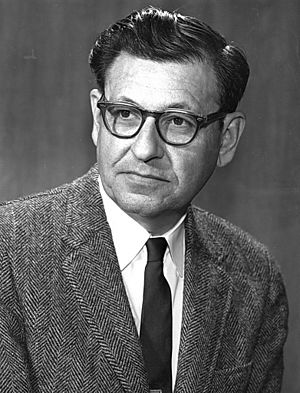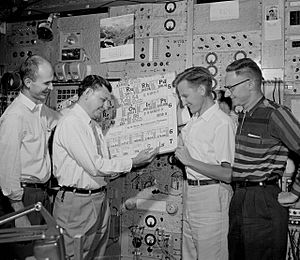Albert Ghiorso facts for kids
Quick facts for kids
Albert Ghiorso
|
|
|---|---|

Albert Ghiorso around 1970
|
|
| Born | July 15, 1915 Vallejo, California, U.S.
|
| Died | December 26, 2010 (aged 95) Berkeley, California, U.S.
|
| Nationality | American |
| Known for | Chemical element discoveries |
| Awards | 2004 Lifetime Achievement Award (Radiochemistry Society), The Potts Medal (Franklin Institute), G. D. Searle and Co. Award (American Chemical Society), Honorary Doctorate (Gustavus Adolphus College), Fellow (American Academy of Arts and Sciences), Fellow (American Physical Society), Guinness Book of World Records (Most Elements Discovered) |
| Scientific career | |
| Fields | Nuclear science |
| Institutions | Lawrence Berkeley National Laboratory |
Albert Ghiorso (July 15, 1915 – December 26, 2010) was an American scientist. He was a nuclear scientist who helped discover a record 12 chemical elements on the periodic table. His work in science lasted for over sixty years, from the early 1940s to the late 1990s.
Contents
Biography
Early Life and Education
Albert Ghiorso was born in Vallejo, California, on July 15, 1915. He grew up in Alameda, California. As a teenager, he loved building radio circuits. He became very good at making radio contacts over long distances.
He earned a degree in electrical engineering from the University of California, Berkeley in 1937. After college, he worked for a company that made radiation detectors. This job connected him with nuclear scientists at the University of California Radiation Laboratory in Berkeley. There, he met Glenn Seaborg and his future wife, Wilma Belt.
Working During Wartime
In the early 1940s, Albert Ghiorso joined Glenn Seaborg to work on the Manhattan Project. This was a secret project during World War II to develop nuclear technology. For four years, Ghiorso created special tools. These tools could detect radiation from nuclear decay.
One of his important inventions was a device that could identify the energy of radiation. This helped scientists figure out where the radiation came from. During this time, they discovered two new elements: element 95, called americium, and element 96, called curium. Their discoveries were kept secret until after the war ended.
Discovering New Elements
After the war, Ghiorso and Seaborg returned to Berkeley. They used a machine called the 60-inch Crocker cyclotron. This machine helped them make elements with higher and higher atomic numbers. They did this by shooting tiny particles at different materials.
- In 1949-1950, they found elements 97 (berkelium) and 98 (californium).
- In 1953, they found elements 99 (einsteinium) and 100 (fermium). These were found in dust collected by airplanes after the first thermonuclear explosion.
- In 1955, they used the cyclotron to make element 101 (mendelevium). This was special because it was the first element discovered atom by atom. Ghiorso invented a "recoil technique" that was key to finding these single atoms.

By the mid-1950s, scientists realized they needed a new, more powerful machine. Ghiorso led the building of the Berkeley Heavy Ion Linear Accelerator (HILAC). This machine helped discover elements 102 through 106:
- 102: nobelium
- 103: lawrencium
- 104: rutherfordium
- 105: dubnium
- 106: seaborgium
Each of these elements was found using only a few atoms. Ghiorso's team developed new ways to handle targets, detect radiation, and process data. An upgrade to the HILAC in 1972 made it even more powerful. This helped them create enough atoms to find element 106.
Finding new elements with even higher atomic numbers became very difficult. In the 1970s and 1980s, other labs, like the GSI laboratory in Germany, took the lead. They discovered elements 107 (bohrium), 108 (hassium), and 109 (meitnerium). Later, elements 110 (darmstadtium), 111 (roentgenium), and 112 (copernicium) were also found there.
More recently, a team in Russia and America found elements 113 through 118. These include nihonium (113), flerovium (114), moscovium (115), livermorium (116), tennessine (117), and oganesson (118). These discoveries completed the seventh row of the periodic table.
Important Inventions
Albert Ghiorso created many new methods and machines. These helped him find and identify heavy elements, sometimes atom by atom. He is known for improving the multichannel analyzer. This tool helps scientists study radiation. He also improved the recoil technique, which helps separate newly made atoms.
Ghiorso also had an idea for a new type of particle accelerator called the Omnitron. This machine would have helped discover many more elements. However, it was never built. Later, he helped combine two existing machines, the HILAC and the Bevatron, to create the Bevalac. This new machine could produce very high-energy particles.
The Bevalac helped create two new areas of research. One was "high-energy nuclear physics," which studies how atomic nuclei behave at high energies. The other was "heavy ion therapy," which uses high-energy particles to treat cancer. These fields are now studied in many labs and clinics around the world.
Later Life and Legacy
In his later years, Ghiorso continued to research superheavy elements and new energy sources. He was listed as a co-author on some experiments in 1999 that seemed to show evidence of elements 116 and 118. However, it was later found that the data was incorrect, and the claims were withdrawn.
Albert Ghiorso is known for co-discovering these elements:
- Americium (element 95) around 1945
- Curium (element 96) in 1944
- Berkelium (element 97) in 1949
- Californium (element 98) in 1950
- Einsteinium (element 99) in 1952
- Fermium (element 100) in 1953
- Mendelevium (element 101) in 1955
- Nobelium (element 102) in 1958–59
- Lawrencium (element 103) in 1961
- Rutherfordium (element 104) in 1969
- Dubnium (element 105) in 1970
- Seaborgium (element 106) in 1974
Ghiorso helped choose some of the names for the new elements. For example, element 106 was named seaborgium after his colleague Glenn Seaborg. This was a big deal because it was named after a living person.
Beyond science, Ghiorso was also known for his creative "doodles" and his love for birdwatching. He even developed a special camera for it. He also strongly supported environmental causes.
See also
 In Spanish: Albert Ghiorso para niños
In Spanish: Albert Ghiorso para niños

